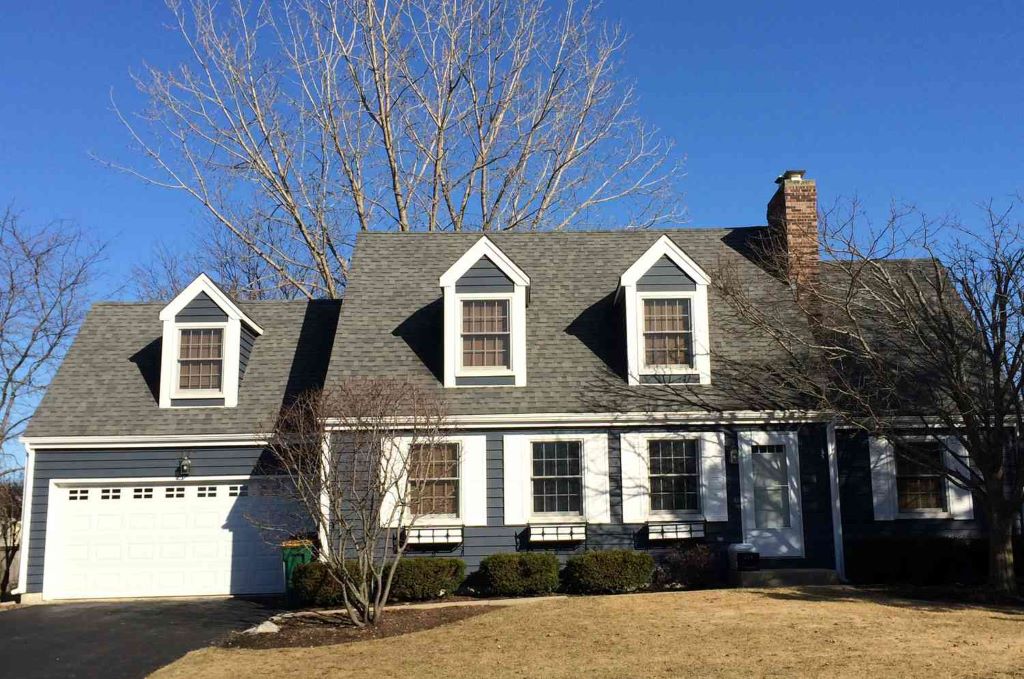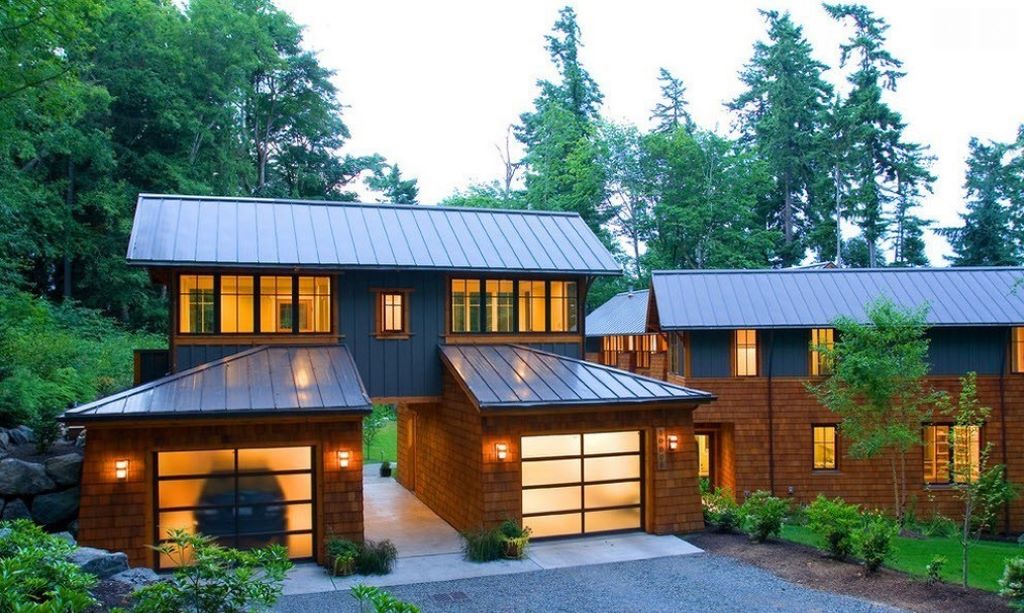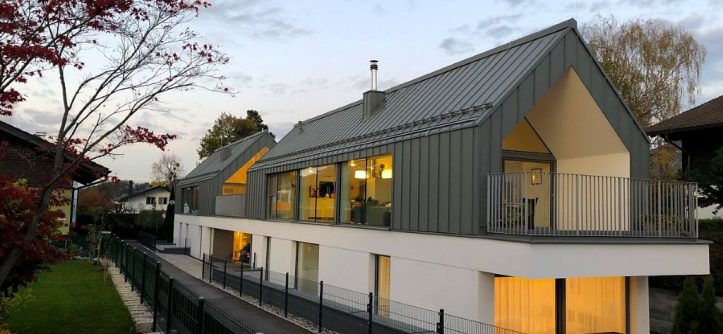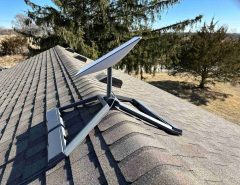A gable roof features two sloping sides that join at a central ridge, creating a peak or triangular shape. It is one of the most popular roofing styles due to its simplicity and functionality.
Characterized by its classic design, a gable roof not only adds aesthetic appeal to homes but also effectively sheds water and snow, protecting the structure from weather damage. This type of roof offers additional space for an attic or vaulted ceilings, and its design allows for better ventilation.
Its straightforward construction typically results in lower building costs compared to more complex roof structures, making it a cost-effective option for many homeowners. With variety in materials and styles, a gable roof can complement a range of architectural designs, from traditional to contemporary. Properly constructed and maintained, gable roofs can enhance both the visual appeal and the resilience of a home.
Introduction To Gable Roofs
Imagine a home with a classic silhouette, standing proudly against the sky — chances are, you’re picturing a gable roof. This enduring roof style not only defines the aesthetics of many dwellings across the globe but also boasts practicality and versatility. In this section, we delve deeper into the quintessential gable roof, exploring its definition, historical significance, and the essential components that make up its structure.

Defining The Gable Roof Style
Gable roofs, often recognized by their triangular shape, are one of the most popular roof styles adorning residential homes. This architectural element is characterized by two sloping sides that come together at a ridge, creating a peak or the ‘gable’ at the top. The simplicity of design, which allows for efficient water runoff and space for an attic or vaulted ceilings, makes gable roofs a timeless choice for homebuilders and homeowners alike.
Historical Significance Of Gable Roofs
The gable roof has roots that run deep into history, its design seen in structures dating back to Ancient Greece. Evolving through the centuries, it has become a symbol of various cultural architectures, from the thatched cottages of medieval Europe to the classical temples of Asia. The prominence in colonial American architecture also highlights the gable roof’s status as a symbol of the pursuit of shelter and security throughout human civilization.
Basic Components And Structure
The foundational elements of a gable roof are relatively straightforward, yet each plays a critical role in its durability and functionality. Here are the basics:
- Ridge: The highest point of the roof where the two sloping sides meet.
- Eaves: The lower edges of the roof that overhang the home’s walls.
- Gable: The triangular portion of the wall between the edges of intersecting roof pitches.
- Rafters: The series of frames that provide the roof with structural support.
- Trusses: Engineered components that supplement rafters, often used in modern gable roof construction for enhanced stability.
These components work in harmony to give the gable roof its distinctive appearance and its well-earned reputation for being both functional and reliable, offering protection against elements in a variety of climates.
Aesthetic Appeal Of Gable Roofs
The gable roof not only stands as a bastion against the elements but also boasts an unmatched aesthetic appeal, cementing its position as a timeless favorite in the world of architecture. With its idyllic pitch and triangular silhouette, the gable roof embodies a sense of classic charm that resonates with nostalgia and contemporaneity alike. Let’s delve into the design intricacies and visual versatility that make gable roofs an enduring choice for homeowners and designers.
Classic Design That Never Goes Out Of Style
There’s a reason classic design endures through the decades; it comes with an inherent elegance that refuses to fade. Gable roofs, with their simple yet striking geometry, are synonymous with the very concept of ‘home’ for many. It’s a look that transcends fleeting trends, ensuring your home retains its curb appeal year after year. Moreover, the symmetrical design promotes not just visual balance but also provides practical benefits, such as effective water run-off, making it a clever choice for areas with heavy rainfall or snow.
Versatility In Aesthetic Customizations
Gable roofs offer ample room for personalization. Homeowners delight in the fact that they can tailor the design to their aesthetic preferences without compromising on functionality. This versatility includes:
- Applying different types of finishes, from rustic shakes to modern metal.
- Incorporating dormers to create visual interest and additional interior space.
- Customizing the slope or pitch for a unique profile.
- Adding eaves, brackets, and other decorative elements that reflect personal style.
Roofing Materials And Color Variations
The choice of roofing material and color plays a pivotal role in defining the look of a gable roof. Durability meets design as homeowners choose from a myriad of options:
| Material | Benefits | Color Range |
|---|---|---|
| Asphalt Shingles | Cost-effective, easy to install | Wide variety |
| Wood Shakes | Natural look, longevity | Earthy tones |
| Metal Roofing | Modern, energy-efficient | Bold and pastel hues |
| Slate Tiles | Luxurious, long-lasting | Natural stone colors |
Scanning through these options, homeowners can match the roof to their home’s palette or go bold with a contrasting shade that makes a statement.
Compatibility With Different Architectural Styles
Gable roofs are not limited to a single architectural blueprint; their adaptability is exceptional. This roofing style graces an array of homes, from quaint cottages to grand estate homes. Notable architectural styles particularly suited to gable roofs include:
- Colonial – where symmetry and classic lines prevail.
- Cape Cod – characterized by a steeply pitched gable roof.
- Craftsman – often featuring intricate eaves and hand-crafted details.
- Tudor – distinguished by steep gable roofs complementing stucco and brick facades.
With each style, the gable roof adds its own distinctive character, contributing to a seamless aesthetic that is both pleasing to the eye and structurally sound.
Functional Advantages Of Gable Roofs

Exploring the world of roofing can lead to the discovery of a variety of styles and designs, but one stands out for its efficiency and practicality: the gable roof. Embraced by homeowners and architects alike, gable roofs not only exude a classic aesthetic but also pack a punch in terms of functionality. Delving into the functional advantages of gable roofs, it becomes clear why they continue to top the list of preferred roofing choices.
Superior Water Drainage Capabilities
The architecture of gable roofs, with their characteristic triangular shape, naturally lends itself to excellent water drainage. This design ensures that rainwater and snow do not linger on the roof’s surface but instead are directed swiftly away due to the steep pitch. Let’s break down why this matters:
- Prevents water accumulation: Water pooling is a non-issue, safeguarding against potential leaks.
- Reduces weight and stress on the roofing structure as water weight is quickly dispelled.
- Minimizes the risk of ice dams in colder climates, protecting the roof from potential water damage.
Enhanced Attic Ventilation And Space
Gable roofs are synonymous with generous attic spaces. The peak of the roof creates a large, often habitable, area that can be utilized for storage, an extra room, or even better, optimal air circulation throughout the home. The benefits include:
- Improved energy efficiency due to the buffering air layer between the living space and the roof.
- An opportunity to install larger windows or vents for superior ventilation.
- Increase in property value thanks to additional usable square footage.
Ease Of Installation And Maintenance
One of the most compelling draws of gable roofs is their simplicity of construction. They require fewer materials and less time to build, which translates into cost savings. This simplicity also extends to ongoing maintenance. Easy access to the roof means:
- Simple inspections and repairs: Identifying and addressing issues is straightforward.
- Accessibility for cleaning gutters and removing debris, keeping the roof in top condition.
Durability And Weather Resistance
With their sturdy design, gable roofs boast an inherent ability to withstand extreme weather conditions. Whether facing fierce winds or heavy snow, a well-constructed gable roof stands its ground. Key elements contributing to this resilience include:
| Feature | Benefit |
|---|---|
| Sloped Surfaces | Limit the impact of heavy snowfall and help resist wind uplift. |
| Reinforced Structures | Internal bracing provides additional stability during volatile conditions. |
Energy Efficiency And Environmental Benefits
Gable roofs are more than just a classic design choice for your home; they can also be a bastion of energy efficiency and an ally to the environment. With the proper design elements and materials, these roofs can effectively reduce energy consumption, lower heating and cooling costs, and contribute to a cleaner, greener earth. Below, explore the numerous ways gable roofs can enhance a building’s energy performance and environmental footprint.
Insulation And Energy Consumption
The right insulation under a gable roof can lead to significant energy savings. Key points to consider include:
- Thermal Resistance: High-quality insulation materials improve the roof’s resistance to heat flow, known as the R-value. A higher R-value means better insulation and more energy saved.
- Airflow: Gable roofs often allow for excellent natural airflow. This design aids in effectively ventilating the attic space, keeping it cool during summer and reducing strain on air conditioning systems.
- Material Selection: Eco-friendly insulation materials such as cellulose or spray foam can substantially lower a building’s carbon footprint.
- Energy Star Ratings: Opting for products that comply with Energy Star standards ensures the resources used contribute to reduced energy consumption.
Opportunities For Roof Greening And Solar Panels
Gable roofs offer a fantastic platform for ecological adaptations, including:
- Roof Greening: Implementing a green roof system enhances biodiversity, provides natural insulation, and reduces stormwater runoff.
- Solar Panel Installation: The slope of a gable roof is ideal for solar panel positioning, maximizing sunlight exposure and energy production.
- Energy Independence: Houses equipped with green roofs and solar panels move towards energy self-sufficiency, decreasing reliance on non-renewable power sources.
Contribution To Sustainable Building Practices
Gable roofs contribute to sustainable building practices in multiple ways:
- Longevity: The geometric simplicity of gable roofs provides excellent durability, which means a longer life-cycle with fewer material replacements.
- Recyclable Materials: Gable roofs can be constructed using sustainable or recycled materials, easing the demand on natural resources.
- Architectural Efficiency: The design reduces the need for complex, resource-intensive structures while still providing ample space and protection for the home.
- Climate Adaptability: Gable roofs perform well under various climatic conditions, reducing the need for additional environmental controls and resource consumption.
Considerations For Choosing A Gable Roof
When pondering the idea of a beautiful new gable roof, the style is often what catches the eye. Yet, there are critical considerations beyond aesthetics to ensure your choice matches your needs, complies with local regulations, and offers the best return on investment. In this section, we explore how to make a well-informed decision when selecting a gable roof for your home.
Assessing The Local Climate For Suitability
Gable roofs are a popular architectural element for many homes. Their steep slopes are particularly beneficial in rainy and snowy climates, where water and snow need to be efficiently directed away from the home to prevent damage. Before deciding on a gable roof, consider:
- Wind patterns and the potential for high-velocity winds which might require additional structural support.
- The average snowfall and the roof’s ability to handle heavy snow loads.
- Local humidity levels, as proper ventilation is vital to prevent moisture accumulation.
Budget And Cost-effectiveness
While gable roofs are known for their simple construction and cost-effectiveness, there are budget-related aspects to evaluate:
- Material costs, which can vary depending on the chosen roofing materials and the design complexity.
- Labor costs, often lower due to the simplicity of design, but fluctuating based on the skill and experience required for your specific roof.
- Longevity of roofing materials and the potential for future maintenance expenses or savings.
Navigating Zoning Laws And Building Codes

It is crucial to understand that every locality has zoning laws and building codes that can significantly influence your roofing project. Failure to comply can lead to fines or even the need to redesign or remove your new roof. Key points include:
| Consideration | Details |
|---|---|
| Local Zoning Laws | Restrictions on height, structural design, or historical area considerations. |
| Building Codes | Specific requirements for materials, pitch, and roof structure. |
| Permits | Necessity for permits before construction begins. |
Long-term Value And Return On Investment
Selecting the right gable roof can have a substantial impact on your home’s future value. In addition to providing timeless curb appeal, consider these points:
- Energy efficiency benefits from proper attic insulation and ventilation, which reduce heating and cooling bills.
- The durability of a gable roof leading to a higher appraisal value and interest when selling.
- Insurance advantages where certain materials or designs offer discounts on premiums due to improved resilience.
Integration With Modern Home Improvements
Smart Roofing Technology And Innovations
In the smart home era, gable roofs are not left behind. Smart roofing technology enriches these traditional structures with cutting-edge features such as automated temperature control, self-cleaning mechanisms, and energy-efficient materials. Innovations in roofing materials mean that gable roofs can now include built-in solar panels, which not only maintain the elegant lines of the roof but also power the home. This integration is both eco-friendly and cost-effective, providing sustainable energy solutions for the modern homeowner.
- Automated Shingles: Shingles that change angle to optimize sunlight reflection.
- Integrated Sensors: Monitors that alert homeowners about the roof’s condition in real-time.
- Thermal Insulation: Advanced materials that bolster energy conservation.
Integrating Skylights And Roof Windows
The integration of skylights and roof windows into gable roofs is an exquisite enhancement that merges aesthetics with practicality. These features not only flood interior spaces with natural light, reducing the need for artificial lighting, but also offer improved ventilation and a touch of luxury. Whether opting for vented, fixed, or tubular skylights, homeowners can custom-fit their gable roofs with these additions to create bright, airy, and more inviting living spaces.
| Type of Skylight | Benefits |
|---|---|
| Vented Skylights | Natural air flow and fresh air circulation |
| Fixed Skylights | Increased daylight and unchanging view of the sky |
| Tubular Skylights | Space-saving design, ideal for smaller areas |
Combining With Other Roof Styles For A Unique Look
Architectural evolution encourages the blending of different styles, and gable roofs are no exception. Home designers often combine gable roofs with other roof styles such as hip, mansard, or flat roofs, creating a unique look that stands out. These combinations often result in additional living space, such as lofts or attics, and can provide a modern twist to a conventional gable roof design. Such creative liberties not only enhance the appeal but also boost the functionality and value of the property.
- Mixed Materials: Utilizing various materials such as metal with traditional shingles to create a distinct aesthetic.
- Hybrid Design: Integrating gable roofs with green roofing systems for eco-conscious homeowners.
- Asymmetrical Gables: Designing gable roofs with varying pitches or lengths for a contemporary edge.
Conclusion: Gable Roofs As A Timeless Choice
As our exploration of residential architecture draws to a close, the spotlight shines firmly on gable roofs—a symbol of tradition and reliability in home design. This iconic roof style, with its distinctive pitched structure, continues to be a top choice for both new constructions and renovations. It offers a balance of aesthetic appeal, practical benefits, and historical significance, making it a perennial favorite in the roofing realm.
Summarizing The Gable Roof Benefits
Gable roofs possess a range of advantages that make them a wise selection for homeowners. Here’s a snapshot of their key benefits:
- Simple Design: Gable roofs boast simplicity, making them easier and more cost-effective to build and maintain.
- Effective Drainage: The sloped design allows for efficient water runoff, reducing the likelihood of water damage and leaks.
- Additional Space: Gable roofs provide extra attic space or vaulted ceilings, offering ample room for storage or additional living areas.
- Ventilation: Their structure supports better air circulation, which helps regulate indoor temperatures.
- Versatility: They suit various architectural styles and can be adapted to different climates by altering the pitch.
The Lasting Impact On Home Design

Gable roofs have deeply influenced home design over the centuries. Their timeless appeal embodies a classic aesthetic that integrates seamlessly into diverse architectural styles, from colonial to contemporary. The adaptability of gable roofs continues to inspire architects and designers, ensuring they remain relevant and coveted in modern home construction.
Not only do they define the skyline with elegant symmetry, but gable roofs also stand as a testament to the notion that well-executed design never goes out of style. Their durable and practical nature aligns with the ongoing trend for sustainable, long-lasting building practices.
Making An Informed Decision For Your Home
Choosing the right roof is crucial in safeguarding and enhancing your property. Gable roofs offer a compelling package of benefits, but it’s essential to consider your specific needs, climate, and architectural preferences. Weigh factors such as local weather patterns, energy efficiency requirements, and personal taste to determine if a gable roof aligns with your expectations.
Engaging with experienced professionals can guide you through the nuances of roof selection, ensuring your home’s crown is both aesthetic and functional. The decision is significant; after all, a roof is not just a shelter—it’s a statement that defines your home’s identity for decades to come.
Frequently Asked Questions For Gable Roof
What Is The Difference Between A Pitched Roof And A Gable Roof?
A pitched roof is any roof with an incline, whereas a gable roof specifically has two sloping sides that form a triangle at each end.
Is My Roof Hip Or Gable?
Identify a hip roof by its slopes on all sides, forming a pyramid. A gable roof has two sloping sides that meet at the top, creating a triangle on each end.
What Are 3 Advantages Of A Gable Roof?
Gable roofs offer excellent water drainage, are cost-effective, and provide more space for the attic or vaulted ceilings.
What Is A Gable And Valley?
A gable is a triangular wall formed by a sloping roof. A valley is where two roof slopes meet, creating a V-shaped depression.
Conclusion
Exploring the gable roof design reveals its timeless appeal and practicality. It stands as a testament to architectural efficiency, blending form with function. Dutch gable roof design: Elegance meets functionality. Whether for residential or commercial structures, the gable roof’s simplicity ensures enduring relevance. By embracing this style, one not only guarantees a blend of aesthetic appeal and structural integrity for years to come but also elevates the architectural sophistication with the timeless charm of Dutch gable design.
Tags: architectural trends, elevated homes, home improvement, home style, house renovation, modern architecture, roof advantages, roof design, stylish living



